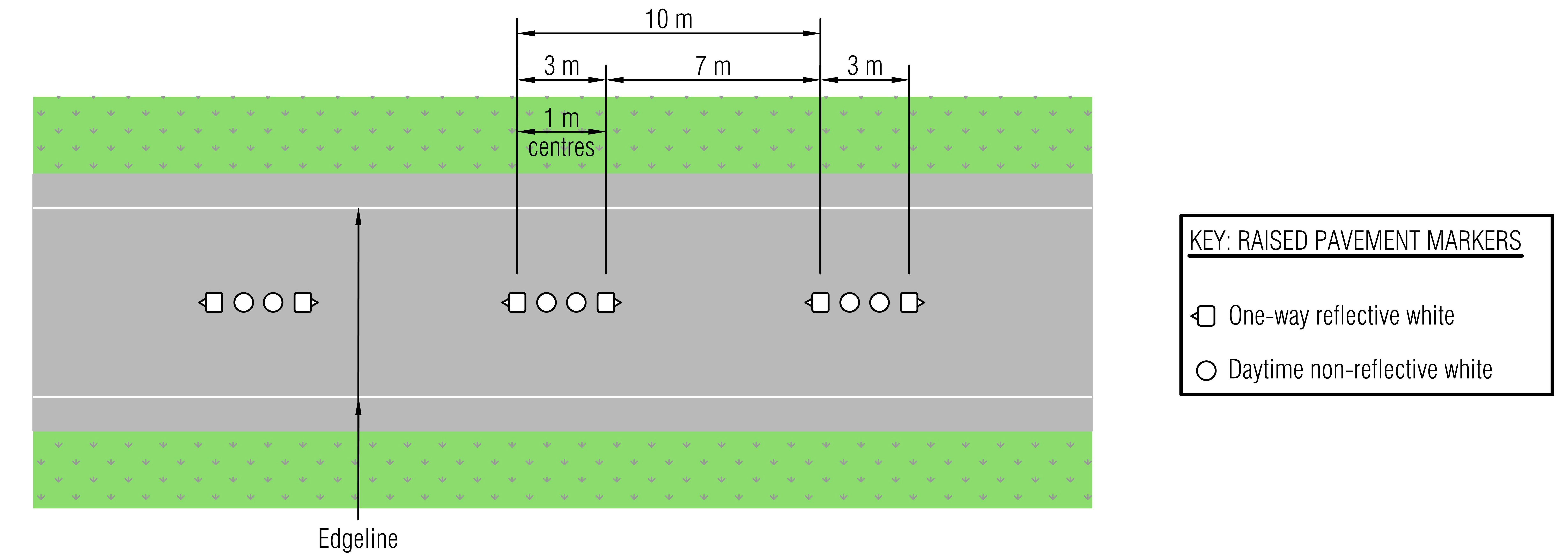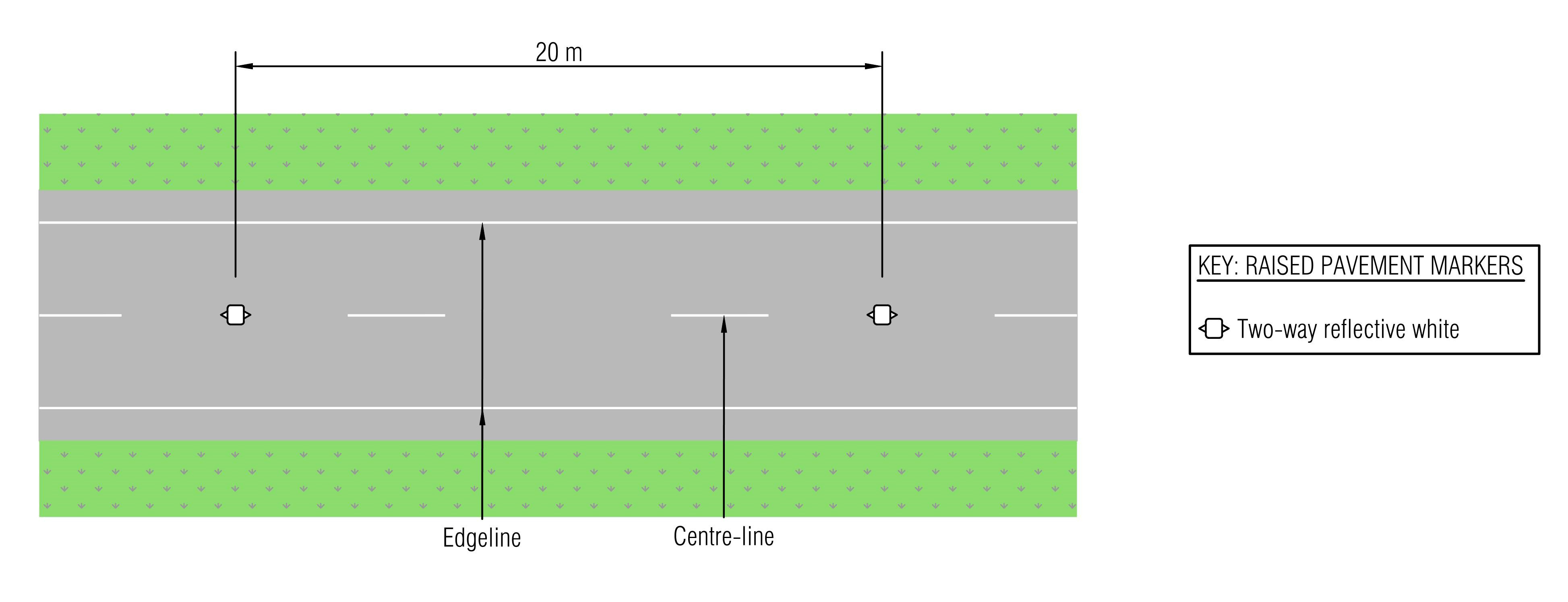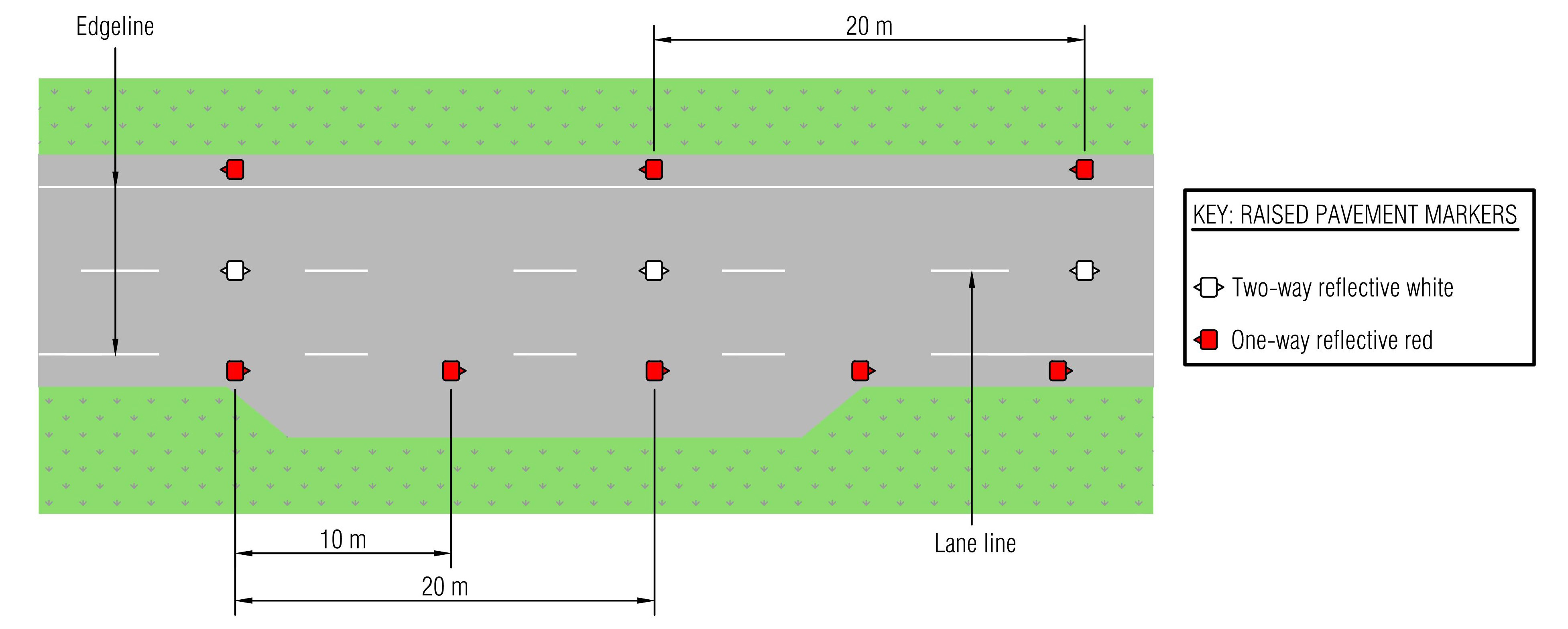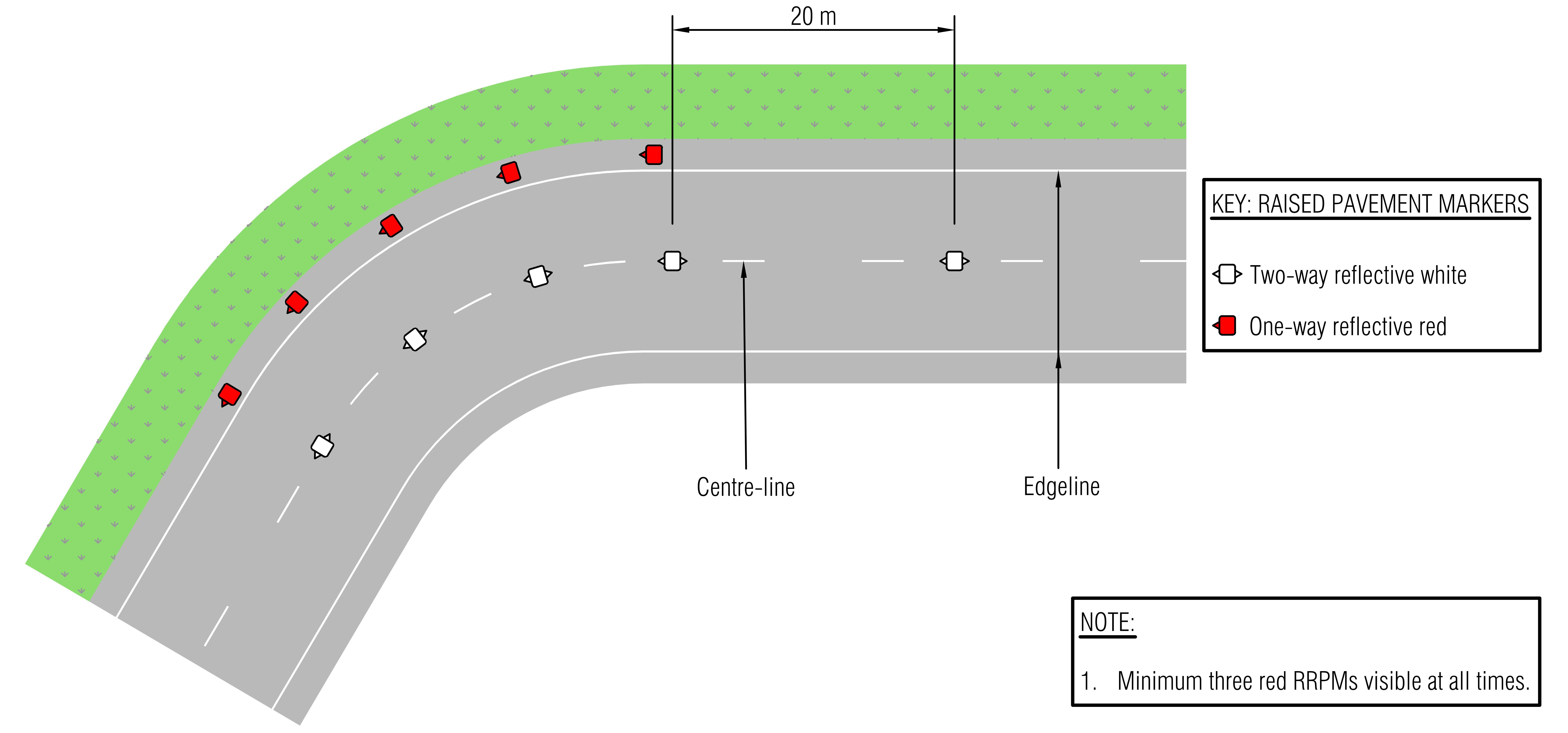For all RRPMs located on centre-lines, the pattern should be uninterrupted except where centre-lines are terminated at intersections and on tight curves. In addition, the orientation of RRPMs on centre-lines should be either Type 2, two-way one-colour or Type 3, two-way two-colours.
On two-lane roads with fine textured surfaces, white centre-line markings may be replaced with RPMs as described in Table 2‑31 with layouts illustrated in Figure 2‑22.
Table 2‑31: Urban and rural pavement markers centre-line arrangement
| Parameters | Urban and rural | |
|---|---|---|
| Centre-line markings | RRPMs | |
| Marker Body Colour | W White |
W White |
| Marker Category | D Daytime non-retroreflective |
G Day/Night retroreflective |
| Retroreflective class | - | Specify Class A, B or C |
| Marker Type | - | 1 One-way one-colour |
| Retroreflective Colour | - | W White |
| Marker ID Code | D-W | G-B1-W |
| Spacing | The two central markers in each group of four should be 1m apart from each other, and 1m apart from the outer reflective markers. Groups of four markers are repeated at 10m intervals along the centre of the road. | |
Table 2‑31 note:
Figure 2‑22 : Centre-line on two-lane roads. Lit/unlit urban and rural lit roads

View larger image [JPG, 2.3 MB]
Two-lane urban and rural roads with fine textured asphaltic surfaces may have painted line markings and raised pavement markers. Category G markers accompanying white centre-lines on urban or rural roads shall show the following retroreflective marker pattern (refer to Figure 2‑23).
In urban areas, marker spacing may be reduced to 10m and be located between each centre-line stripe.
The pattern of markers shall not be interrupted except where centre-lines are terminated at intersections and on tight curves.
Table 2‑32: Marker detail for two-lane rural and urban roads
| Parameters | With painted centre-line |
|---|---|
| Centre-line markings | |
| Marker Body Colour | W White |
| Marker Category | G Day/Night retroreflective |
| Retroreflective class | Specify Class A, B or C |
| Marker Type | 2 Two-way one-colour |
| Retroreflective Colour | W White |
| Marker ID Code | G-B2-W |
| Spacing | Nominally 20m |
| Location | Central in every second gap between centre-line strips |
Figure 2‑23: Two-lane urban and rural roads centre-line

View larger image [JPG, 732 KB]
For curvilinear alignments, the spacing between RRPMs may be reduced to a minimum of 10m and arranged so that at least three consecutive markers are always visible to approaching drivers.
At intersections, markers shall be placed at the intersection end of each solid centre-line. Markers shall also be placed at equal intervals, not exceeding 20m, along the full length of solid centre-lines.
Where sections of multi-lane undivided roads are surfaced with fine textured asphalt, the arrangement of RRPMs accompanying white lane lines in urban and rural areas should show the retroreflective configuration shown in Table 2‑33 and Figure 2‑34.
Table 2‑33: Application for urban and rural lane lines
| Parameter | In conjunction with painted lane and centre-lines | |
|---|---|---|
| Lane lines | Centre-lines | |
| Marker Body Colour | W White |
W White |
| Marker Category | G Day/Night retroreflective |
G Day/Night retroreflective |
| Retroreflective class | Specify Class A, B or C | Specify Class A, B or C |
| Marker Type | 1 One-way one-colour |
2 Two-way one-colour |
| Retroreflective Colour | W White |
W White |
| Marker ID Code | G-B1-W | G-B2-W |
| Spacing | Nominal 10m | Nominal 10m |
| Location | On the lane line at the approach end of each stripe | On the centre-line at the midpoint of each lane line stripe |
Figure 2‑24: Line marking with raised pavement markers

View larger image [JPG, 2.7 MB]
Along unlit corridors where there is a proven need for better route guidance or general safety concerns, the left-hand edgeline may be supplemented with Category G retroreflective, Type 1 one-way, red RRPMs. These RRPMs may also be used for edgeline delineation when:
Table 2‑34 : Arrangement of edgeline retroreflective raised pavement markers
|
|
Rural roads left-hand edgeline RRPMs |
|
|---|---|---|
|
|
Edgelines |
Centre-lines |
|
Marker Body Colour |
R |
W |
|
Marker Category |
G |
G |
|
Retroreflective class |
Specify Class A, B or C |
Specify Class A, B or C |
|
Marker Type |
1 |
2 |
|
Retroreflective Colour |
R |
W |
|
Marker ID Code |
G-B1-R |
G-B2-W |
|
Spacing |
10m and 20m; see the notes for |
20m |
|
Location |
To the left of the continuity line, in line with the midpoints between each painted centre-line dash |
Midway between every alternate painted centre-line dash. |
Figure 2‑25 : Rural roads left-hand edgelines RRPMs
 View larger image [JPG, 891 KB]
View larger image [JPG, 891 KB]
Table 2‑35: Arrangement of edgeline retroreflective raised pavement markers
|
|
Rural roads left-hand edgelines - curves |
|
|---|---|---|
|
|
Edgelines |
Centre-lines |
|
Marker Body Colour |
R |
W |
|
Marker Category |
G |
G |
|
Retroreflective class |
Specify Class A, B or C |
Specify Class A, B or C |
|
Marker Type |
1 |
2 |
|
Retroreflective Colour |
R |
W |
|
Marker ID Code |
G-B1-R |
G-B2-W |
|
Spacing |
Nominal 20m; refer note 1 |
10m and 20m |
|
Location |
Midway between every second painted centre-line dash |
Midway between every alternate painted centre-line dash. |
Table 2‑35 note:
Figure 2‑26: Rural roads left-hand edgelines – curves

View larger image [JPG, 2.9 MB]
These edgelines serve a similar function to no-passing lines and in unlit areas, white retroreflective raised pavement markers should be used to highlight the flush median.
Along unlit corridors where either a raised median or a median barrier is installed, the edgelines adjacent to that facility should be supplemented with yellow retroreflective raised pavement markers (refer to Table 2‑36 and Figure 2‑27).
Table 2‑36: Arrangement of edgeline retroreflective raised pavement markers
| Parameter | Raised median or median barrier edgelines | |
|---|---|---|
| Lane lines | Raised median or median barrier edgelines | |
| Marker Body Colour | W White |
Y Yellow |
| Marker Category | G Day/Night retroreflective |
G Day/Night retroreflective |
| Retroreflective class | Specify Class A, B or C | Specify Class A, B or C |
| Marker Type | 1 One-way one-colour |
1 One-way one-colour |
| Retroreflective Colour | W White |
Y Yellow |
| Marker ID Code | G-B1-W | G-B1-Y |
| Spacing | 10m | 10m |
Figure 2‑27: Raised median or median barrier edgelines
View larger image [JPG, 1.3 MB]
Red RRPMs may be used on the left edgeline:
Table 2‑37: Arrangement of edgeline retroreflective raised pavement markers
| Parameter | Raised median or median barrier edgelines | |
|---|---|---|
| Left-hand edgeline in advance of kerb extensions | Raised median or median barrier edgelines | |
| Marker Body Colour | R Red |
Y Yellow |
| Marker Category | G Day/Night retroreflective |
G Day/Night retroreflective |
| Retroreflective class | Specify Class A, B or C | Specify Class A, B or C |
| Marker Type | 1 One-way one-colour |
1 One-way one-colour |
| Retroreflective Colour | R Red |
Y Yellow |
| Marker ID Code | G-B1-R | G-B1-Y |
| Spacing | 5m | 10m |